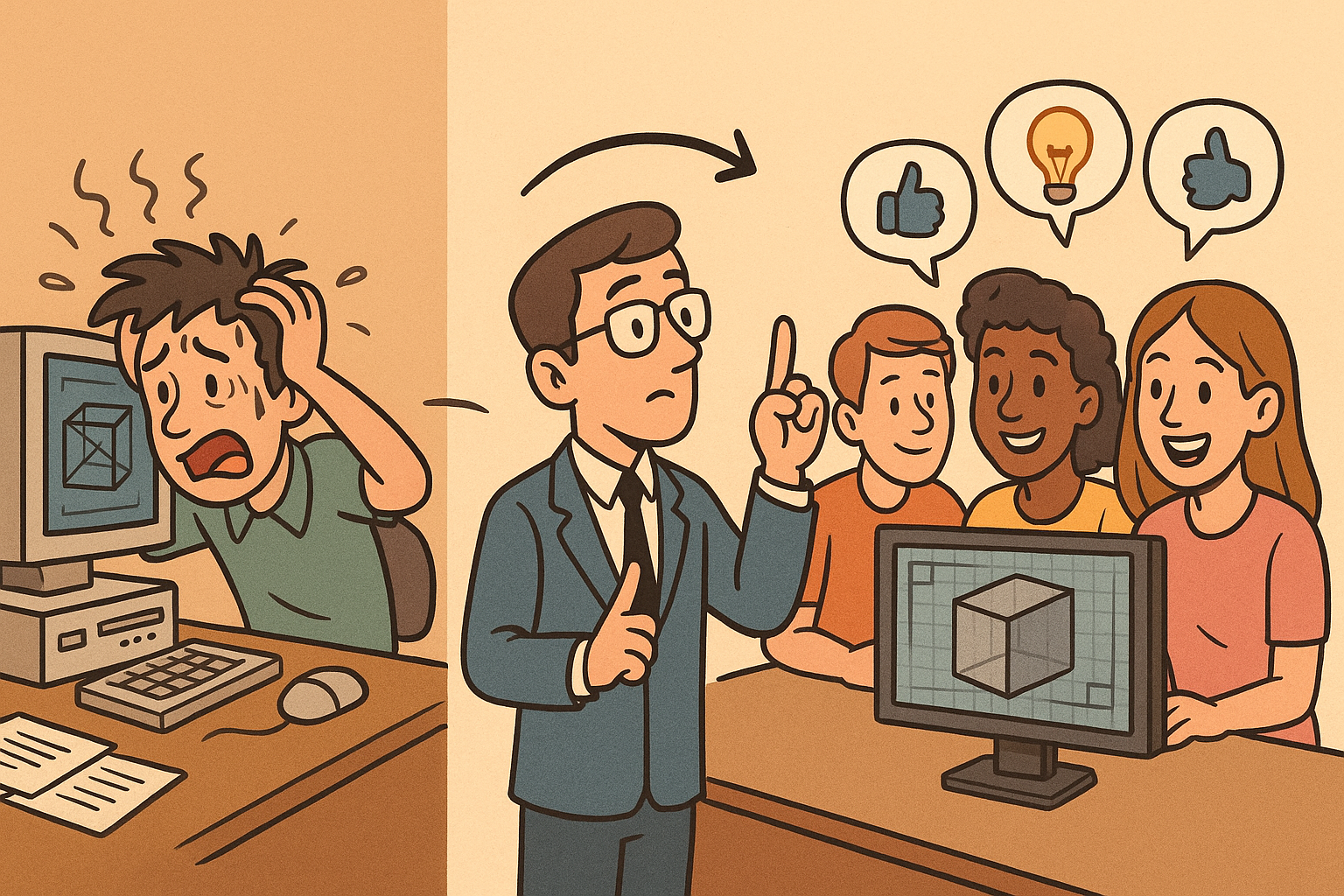Your Cart is Empty
Customer Testimonials
-
"Great customer service. The folks at Novedge were super helpful in navigating a somewhat complicated order including software upgrades and serial numbers in various stages of inactivity. They were friendly and helpful throughout the process.."
Ruben Ruckmark
"Quick & very helpful. We have been using Novedge for years and are very happy with their quick service when we need to make a purchase and excellent support resolving any issues."
Will Woodson
"Scott is the best. He reminds me about subscriptions dates, guides me in the correct direction for updates. He always responds promptly to me. He is literally the reason I continue to work with Novedge and will do so in the future."
Edward Mchugh
"Calvin Lok is “the man”. After my purchase of Sketchup 2021, he called me and provided step-by-step instructions to ease me through difficulties I was having with the setup of my new software."
Mike Borzage
Design Software History: The Evolution of CAD Software: From Early Challenges to Community-Driven Innovation and Support Systems
July 27, 2025 8 min read


Introduction and Historical Context
The early days of CAD software development were marked by both technological innovations and formidable challenges that set the stage for an evolving community of users. In the 1960s and 1970s, CAD software began as rudimentary tools designed for technical drawings and engineering calculations. Despite the revolutionary nature of these tools, the hardware limitations and the nascent state of computer graphics posed significant obstacles. Pioneers in the field often struggled with limited memory, slow processors, and lack of robust graphical interfaces, making the user experience both complex and inaccessible for many professionals. Despite these challenges, early adopters demonstrated remarkable perseverance, experimenting with early systems that would eventually evolve into more sophisticated design packages. As a result, users quickly discovered that a combined effort in knowledge sharing and collaborative troubleshooting could significantly enhance the usability of these early systems. This insight would later foster the emergence of rich user communities that provided tailored support, nurtured creative problem solving, and eventually contributed to major software advancements.
Early CAD Challenges
In this foundational period, users encountered numerous hurdles that impeded the rapid adoption of CAD technology. The proprietary nature of many early systems meant that technical know-how was confined to small groups within academic institutions or specialized industries. Many users experienced difficulties interpreting and manipulating the underlying code for basic operations. Hardware constraints further limited the ability to process detailed 3D models or complex simulations, leading to frustration and unmet expectations. These limitations prompted users to seek alternative avenues for troubleshooting that fell beyond the reach of their immediate technical support channels.Community-Driven Support Emergence
The limitations of early CAD systems catalyzed a need for peer-to-peer support, which laid the groundwork for community-driven knowledge bases. Early user groups, often informal and interspersed among academic and professional circles, began to communicate through mailing lists and bulletin board systems (BBS). These communication channels allowed users to share insights, workarounds, and custom modifications, thus bridging the gap left by official support. In bullet-point format, the key drivers of this trend can be summarized as follows:- Shared frustrations over hardware and software constraints.
- Desire to optimize and customize early CAD interfaces.
- Collaborative experimentation to overcome limited functionalities.
Evolution of User Communities and Forums
From the era of offline meetings and localized discussions, the evolution of CAD community forums has transformed the landscape of design software support. In the early days, face-to-face interactions and teleconferences were predominant, yet these methods were limited in reach and scope. Rapid technological advancements in internet communication paved the way for online platforms, evolving from primitive mailing lists and newsgroups to dedicated forums that provided instantaneous response capabilities and wider audience engagement. This digital transition empowered users to connect across vast geographical boundaries while enabling quicker, more diverse problem-solving avenues. These forums played a crucial role not only as a troubleshooting hub but also as a venue for sharing innovative ideas that enriched the overall CAD ecosystem.
From Offline to Online: The Transition
Initially, user groups met during conferences or through local user clubs, where technical insights were exchanged in person. However, as the internet blossomed, platforms such as early newsgroups and BBS expanded these interactions globally. This dramatic shift provided users access to collective wisdom from various industries and educational backgrounds. As time progressed, specialized CAD support websites emerged, each supported by enthusiastic communities eager to share experiences and best practices. The digital environment not only democratized access to support but also established a dynamic feedback loop between software developers and users. Users began offering constructive criticism and proposing enhancements, which developers could later integrate into iterative software updates. In summary, the move from offline meetings to online communities revolutionized the way technical support and innovation in CAD software were handled.Key Milestones and Influential Platforms
As the community moved to online platforms, several milestones significantly contributed to the support and advancement of CAD software. Notable among these developments was the establishment of dedicated websites and forums specifically designed for CAD users. Classic examples include the progressive forums hosted by renowned companies such as Autodesk, where in-depth discussions about emerging features and industry standards became common. Another milestone was the development of independent, third-party groups, which provided platforms for innovative problem-solving strategies. The emergence of these influential platforms provided multiple layers of support and feedback for users, leading to a mutually beneficial dialogue that catalyzed significant product enhancements. Notable bullet points that summarize these influential milestones include:- Establishment of online mailing lists and newsgroups catered to CAD issues.
- The creation of dedicated user forums by established companies like Autodesk.
- Active participation in independent groups that focused on collaborative problem-solving.
Influential Third-Party Communities
The growth of third-party platforms has been integral in molding the collective expertise of the CAD user community. These platforms, driven by passionate enthusiasts, magnified the potential of early CAD software by focusing on user-generated content, including plugins, custom scripts, and frequently encountered workarounds. Their grassroots approach helped introduce robust, community-approved modifications that quickly gained popularity among professionals. Independent groups leveraged their collective expertise to challenge established norms, proposing radical enhancements that targeted areas previously overlooked by commercial developers. This shift underlined the importance of bottom-up innovation, which complemented traditional, top-down development approaches typically seen in industry giants. As these communities thrived, they became a vital resource, disseminating technical know-how and spurring new ideas—ultimately transforming the way CAD software was perceived and utilized across industries.Impact on CAD Software Support and Innovation
The advent of active, online user communities has had a profound impact on both CAD software support and the rate of innovation. As a result of these platforms, users found themselves participating in a two-way exchange with developers, where troubleshooting went beyond solving technical glitches to inspiring the creation of new features and software functionalities. By virtue of sharing experiences and creative solutions on these online forums, professionals were able to pinpoint common issues and propose viable modifications that could be implemented in future software releases. This form of reciprocal dialogue has fostered a culture where user contributions are highly valued. It has also cultivated an environment where the evolution of design software is driven not only by technological advancements but also by direct community influence.
Enhanced Troubleshooting and Customization
One of the paramount contributions from user communities is their extensive role in troubleshooting. Many users turned to these forums to seek guidance on obscure issues and workaround strategies that had previously stymied productivity. The collaborative nature of these groups meant that a single question could generate multiple solutions from different professional backgrounds, ensuring that recommendations were both robust and tested across various scenarios. Moreover, these communities have been pivotal in paving the way for customization of CAD platforms. Users have shared code snippets, custom tools, and plugins that have enabled even those working on legacy systems to access new features. The collaborative input often takes the form of bulleted lists and consolidated knowledge bases that provide:- Detailed error resolution steps and best practices.
- In-depth tutorials on plugin and script integration.
- Shared repositories of user-generated enhancements.
Feedback Loops and Developer Engagement
The synergy between developers and users is best illustrated by the robust feedback mechanisms that have evolved over time. Developers, recognizing the invaluable input of a passionate user base, have increasingly incorporated community suggestions into product updates and strategic planning. The direct feedback loop promoted by these forums accelerates the product lifecycle by preemptively identifying bugs and performance bottlenecks. Developers can prioritize new features based on the frequency and severity of issues reported by users. Not only does this process result in a more stable and user-friendly product, but it also enhances the reputation of the software vendor as one that listens to and values its community. Multiple bullet points that underscore these benefits include:- Accelerated development cycles with targeted updates.
- Direct, real-time communication between users and developers.
- Higher user satisfaction through customized solutions.
User-Driven Innovations and Collaborative Practices
The spirit of collaboration within these communities has also paved the way for groundbreaking user-driven innovations that continue to influence the design software industry. Across multiple forums, detailed discussions into niche functionalities and obscure design methodologies have led to the development of shared plugins and scripts that have become industry standards. Users, often driven by the necessity to overcome the rigid constraints of traditional CAD systems, have experimented with novel approaches to modeling and simulation. These innovations have not only improved workflow efficiency but have also met specific industry needs that were previously overshadowed by general-purpose software packages. The culture of sharing and constant iteration means that many of the tools developed on community platforms have transcended uses to become integrated features within mainstream CAD products. The benefits of this interaction can be summarized in the following bullet points:- Development of customized scripts and plugins improving operational efficiencies.
- Emergence of best practices that are now widely accepted in the industry.
- Proliferation of collaborative tools that address niche design challenges.
Conclusion
In summary, the evolution of user communities and forums has fundamentally transformed the CAD landscape. Early challenges in CAD software spurred the need for community-based troubleshooting and customization, laying the groundwork for the dynamic and collaborative support systems we witness today. The journey from offline meetings to influential online forums has not only broadened the reach of technical support but has also established a feedback-rich environment that encourages the perpetual improvement of design software. The direct involvement of users in the development process has helped create streamlined workflows and innovative solutions tailored to real-world challenges. Furthermore, the influence of these groups extends beyond mere problem resolution; they have actively contributed to software evolution by sharing original ideas and stand-alone tools that are now integral to many CAD systems.
Redefining CAD Software Support
The transformative role of user communities can be observed in the many ways they have redefined software support. By establishing a symbiotic feedback loop between users and developers, online communities have ensured that software updates are not only reflective of contemporary challenges but also strategic in anticipating future needs. These forums, fueled by creative energy and persistent collaboration, have emerged as vital platforms where innovation thrives. Through persistent troubleshooting, customization, and the sharing of best practices, users have allowed the CAD industry to adapt in ways that were previously unimaginable. The comprehensive support structure developed through these forums has now become an indispensable component of modern design software ecosystems, characterized by high adaptability and rapid technological advances.Future Outlook and Continued Impact
Looking forward, the collaborative model fostered by early user groups and online communities is set to continue its influential role in shaping the future of design software. As CAD technology evolves with trends such as additive manufacturing, artificial intelligence, and cloud-based design platforms, these established community networks will undoubtedly confront new challenges while also unearthing fresh opportunities. The lessons learned from decades of community-driven innovation, such as the importance of direct user feedback, customizable environments, and rapid knowledge exchange, will remain crucial. The sustained integration of user-driven insights into product development models provides a robust foundation for future advances and assures that the spirit of collaboration and continuous improvement remains a constant driving force in the evolution of CAD software. In essence, while the technical landscape may evolve, the core values of community, collaboration, and shared innovation are here to stay.Also in Design News

Rhino 3D Tip: AOV-Based Render Pass Workflow for Rapid, Non‑Destructive Compositing
December 28, 2025 2 min read
Read More
Cinema 4D Tip: Consolidate Geometry with Connect Objects + Delete
December 28, 2025 2 min read
Read More
V-Ray Tip: Region Rendering Best Practices for Fast, Seamless Comp Patches
December 28, 2025 2 min read
Read MoreSubscribe
Sign up to get the latest on sales, new releases and more …


